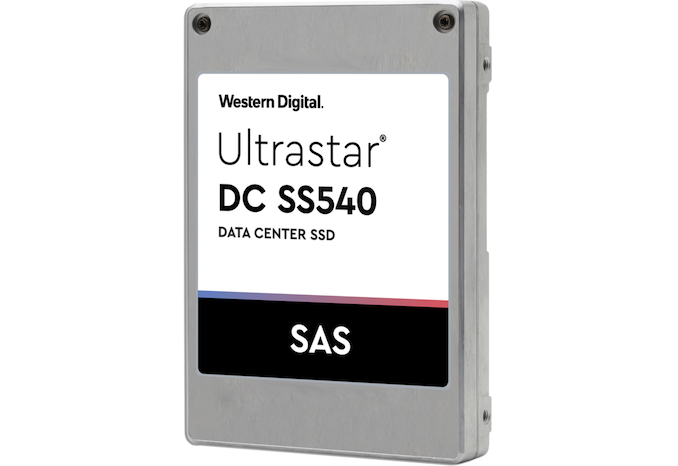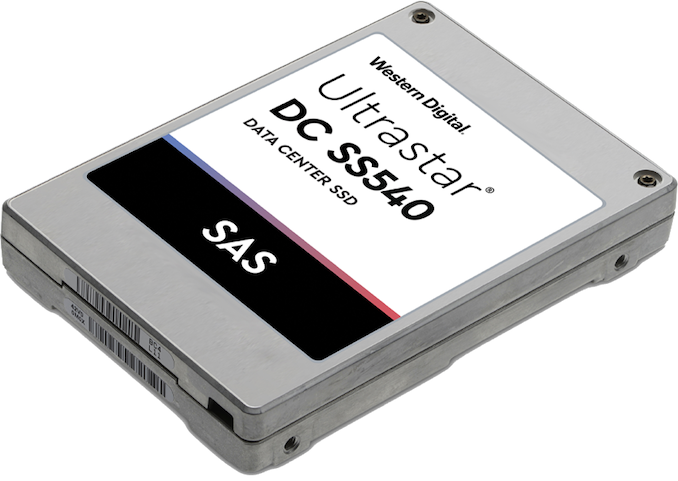Western Digital Ultrastar DC SS540 SAS SSDs: Up to 15.36 TB, Up to 3 DWPD
by Anton Shilov on November 6, 2019 3:00 PM EST
Western Digital has introduced its new series of SSDs designed for mission critical applications, including OLTP, OLAP, hyper converged infrastructure (HCI), as well as software-defined storage (SDS) workloads. The Ultrastar DC SS540 drives are aimed at mixed and write intensive workloads and can be configured accordingly. Since the SSDs use an SAS 12 Gbps interface, they are drop in compatible with existing machines.
The Western Digital Ultrastar DC SS540 is based on the company's sixth-generation dual-port SAS 12 Gbps platform co-developed with Intel as well as 96-layer 3D TLC NAND memory (presumably, also from Intel) and comes in a 2.5-inch/15 mm form-factor. The new SSDs are drop-in compatible with existing servers that support 9, 11, and 14 W per drive power options (SKUs with higher power consumption offer higher random read/write speeds).
As is traditional for SAS SSDs from Western Digital and Intel, the Ultrastar DC SS540 supports extended error correction code (ECC with a 1x10^-17 bit error rate) to ensure high performance and data integrity, exclusive-OR (XOR) parity in case a whole NAND die fails, and parity-checked internal data paths. In addition, the Ultrastar SS540 complies with the T10 Data Integrity Field (DIF) standard, which requires all interconnect buses to have parity protection (on the system level), as well as a special power loss data management feature that does not use supercapacitors. As usual, Western Digital's Ultrastar SS540 will be available in different SKUs with capabilities like instant secure erase and/or TCG+FIPS encryption to conform with various security requirements.
The manufacturer plans to offer the Ultrastar DC SS540 rated for 1 or 3 drive writes per day (DWPD) to target different workloads. The former will offer capacities between 960 GB and 15.36 TB, whereas the latter will feature capacities from 800 GB to 6.4 TB. The new lineup does not include drives rated for 10 DWPD and less than 1 DWPD, so those who need higher or lower endurance (as they run extremely read intensive or extremely write intensive workloads) will have to use previous-generation offerings from Western Digital. When it comes to warranty and MTBF, the drives are rated for a 0.35% annual failure rate (AFR), 2.5 million hours MTBF and are covered with a five-year limited warranty (or the max PB written, whichever occurs first).
As far as sustained performance is concerned, the Ultrastar DC SS540 is rated for up to 2130 MB/s sequential read/write speed, up to 470K IOPS random write IOPS, and up to 240K random write IOPS, depending on exact model, which is generally in line with performance of the Ultrastar DC SS530 SSDs launched last year. Traditionally, higher capacity SSDs are slightly slower when it comes to writes and mixed workloads, but those who need maximum performance can always use more drives to hit desired speeds.
Western Digital’s Ultrastar DC SS540 SSDs are currently sampling and qualified by select clients of the company. The manufacturer plans to start commercial shipments of the drives in the Q1 2020.
| HGST Ultrastar SS540 Series Specifications | |||
| 3 DWPD | 1 DWPD | ||
| Capacities | 6.4 TB 3.2 GB 1.6 TB 800 GB |
15.36 TB 7.68 TB 3.84 TB 1.92 TB 960 GB |
|
| Form Factor | 2.5"/15mm | ||
| Interface | SAS 6/12 Gb/s, dual port for 12 Gb/s | ||
| Controller | Proprietary | ||
| NAND | 96-layer 3D TLC NAND |
||
| Sequential Read | 2116 ~ 2130 MB/s | 1985 ~ 2130 MB/s | |
| Sequential Write | 1008 MB/s ~ 2109 MB/s | 1985 MB/s ~ 2130 MB/s | |
| Random Read (4 KB) IOPS | 237K ~ 470K IOPS | 237K ~ 470K IOPS | |
| Random Write (4 KB) IOPS | 128K ~ 240K IOPS | 79K ~ 110K | |
| Mixed Random R/W (70:30 R:W, 4KB) Max IOPS |
182K ~ 300K IOPS | 143K ~ 200K IOPS | |
| Read/Write Latency (average) | 140/60 μs ~ 150/80 μs | 140/90 μs ~ 150/300 μs | |
| Power | Idle | 3.7 W (<15 TB) - 4.7 W (>15 TB) | |
| Operating | 9 W, 11 W, 14 W (configurable) | ||
| Endurance | DWPD | 3 | 1 |
| Max. PB | 6.4 TB: 36,150 TB 3.2 TB: 17,150 TB 1.6 TB: 9,410 TB 800 GB: 4.700 TB |
15.36 TB: 30,110 TB 7.68 TB: 15,050 TB 3.84 TB: 7,000 TB 1.92 TB: 3,760 TB 960 GB: 1,880 TB |
|
| Encryption | AES-256 (?) TCG + FIPS |
||
| Power Loss Protection | Yes | ||
| MTBF | 2.5 million hours | ||
| Warranty | Five years or max PB written (whichever occurs first) | ||
| Models | WUSTR6464ABSS20x WUSTR6432BSS20x WUSTR6416BSS20x WUSTR6480BSS20x |
WUSTVA1A1BSS20x |
|
| Legend for Model Numbers | Example: WUSTR6464ASS201=6.4TB, SAS 12Gb/s, TCG W = Western Digital U = Ultrastar S = Standard TR = NAND type/endurance (TM=TLC/mainstream endurance, TR=TLC/read-intensive) 64 = Full capacity (6.4TB) 64 = Capacity of this model 15 = 15.2TB 76 = 7.6TB 38 = 3.84TB 32 = 3.2TB 19 = 1.92TB 16 = 1.6TB 96 = 960GB 80 = 800GB 48 = 480GB 40 = 400GB A = Generation code S = Small form factor (2.5” SFF) S2 = Interface, SAS 12Gb/s 1 = Encryption setting 0 = Instant Secure Erase 1 = TCG Enterprise encryption 4 = No encryption/Secure Erase 5 = TCG+FIPS |
||
Related Reading:
- HGST Launches Ultrastar DC SS530 SSDs: 3D TLC NAND, 15.36 TB, SAS 12 Gbps
- Western Digital Reveals Ultrastar DC SN340 SSDs for Read Intensive Workloads
- Western Digital Launches HGST Ultrastar SS300 SSDs: 3D NAND for Data Centers
- HGST Ultrastar SS200 SSD: Up to 7.68 TB, 1.8 GB/s, Dual-Port SAS 12 Gbps
- HGST Ultrastar SN200 Accelerator: 7.68 TB Capacity, 6.1 GB/s Read Speed, 1.2M IOPS
Source: Western Digital











20 Comments
View All Comments
Huacanacha - Wednesday, November 6, 2019 - link
Looking at the data sheet the latency units should be microseconds (μs) not milliseconds (ms). Hundreds of milliseconds would be crazy and near unusable latency for an SSD... might as well use a hard drive in that case ;)https://documents.westerndigital.com/content/dam/d...
Anton Shilov - Thursday, November 7, 2019 - link
Thanks for sharp eyes. Fixed!DanNeely - Thursday, November 7, 2019 - link
I'm still seeing ms for the first pair in the ranges. Did you miss those errors, or should I blame caching?Santoval - Thursday, November 7, 2019 - link
I see them as well, I don't think they are due to caching.yetanotherhuman - Thursday, November 7, 2019 - link
What I want to know is: why did the consumer never get a 12Gbps SATA?Foeketijn - Thursday, November 7, 2019 - link
The only moment you'll notice a sATA 600 being connected to a sATA 300 chip is when you move a big file from 1 SSD to the other.Most people only have 1 SSD per computer.
Going from 600 to 1200 only makes the platform more expensive and power hungry.
I can't notice a difference when working on a Samsung 830 or a Samsung 970 evo except when the 830 uses Rapid mode.
DanNeely - Thursday, November 7, 2019 - link
Because consumer HDDs never got fast enough to come close to saturating SATA like 15k RPM drives did for enterprise. And because the SATA/SAS driver stack has too much overhead to be efficient for SSDs; so for faster SSDs they created a new one that fits with how flash works called NVME instead.If we ever get 12GB SATA it'lll because spinning rust is still the cheapest way to store bulk data 5 or 10 years from now and the biggest HDDs are able to saturate SATA-6GB.
Santoval - Thursday, November 7, 2019 - link
They did. SATA 3.0 has a speed limit of 6 Gbit/s (as you must surely know) but SATA 3.2, which was released in 2013, has a speed limit of 16 Gbit/s. SATA 3.2 is more commonly known as "SATA Express". SATA Express supports legacy SATA, legacy PCIe 2.0/3.0 via AHCI and even PCIe 2.0/3.0 over NVMe.It can only use two PCIe lanes though, so when using two PCIe 3.0 lanes it can reach a raw speed of 16 Gbit/s (2 × 8 GT/s), or an effective speed of a hair below 2 GB/s (1970 MB/s). SATA Express was largely unsuccessful, and is barely a thing today, due to the appearance and prevalence of the more flexible M.2/U.2 ports for small internal SSDs, which were designed to work primarily with NVMe (I am not sure about U.2 but M.2 also supports SATA 3.0, though largely for backwards compatibility).
Santoval - Thursday, November 7, 2019 - link
edit : Disregard the bits about the U.2 connector. I am not sure what I had in mind but U.2 is not exactly as small as M.2. In fact U.2 is mechanically identical to the SATA Express device plug, so in a sense SATA Express "survives" through it.PeachNCream - Thursday, November 7, 2019 - link
I miss my 6.4GB Western Digital Caviar drive. It was an upgrade dropped into a 100MHz Pentium desktop to replace the 1.6GB drive. Between that and feeding it 32MB of RAM (upgraded from 8MB) it was a good system aside from the 1MB Trident VGA controller which I never did get around to upgrading.